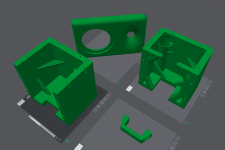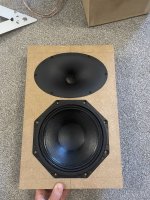Oops yes my mistake; I had meant the SB15CAC had shorting rings, and lower midrange distortion, than the SB12CAC! My mistake, I get the ranges confused all the time. Obviously, it's one consideration among many, but I thought I'd point it out in case you weren't aware.SB13? From their entry-level line? No I haven't. I doubt the motor is worse in the midrange line, but yes I think the 12cm does not have shorting rings. They probably have similar motors, so I'll take the white cone to match the rest of the drivers. And it has extended response on and off axis so it will be easy to work with.
He's an over due update on my 3d printed enclosure using Augerpro's SB26ACD waveguide and the SB15CAC woofer. I made a quick and dirty crossover and took a few measurements at my desk to see how it measured:

It's a 10" x 10" x 12.5" box, with a 7" x 1.5" port in the back. It's not fully closed in the back because I'm still waiting on the binding post bracket to get in, so the bass measurement isn't accurate.

Over the next week or so I'll take some ground plane measurements in my garage and tweek the crossover.
It's a 10" x 10" x 12.5" box, with a 7" x 1.5" port in the back. It's not fully closed in the back because I'm still waiting on the binding post bracket to get in, so the bass measurement isn't accurate.
Over the next week or so I'll take some ground plane measurements in my garage and tweek the crossover.
But here we have 99dB without waveguide at a lower voltage. And >105dB with waveguide - from the small tweeter.I've tested the 34b in the 8'' circular waveguide and it measured higher then that
103db at 2.83 ?
The few T25B I measured couldn't do that ;-)
SB15CAC seem to be a gem in their lineup. It should be possible to build a very nice KH120 like speaker with it - a handy speaker size.
My next project will be a rear speaker with MW13TX and T25A - but without waveguide for as wide as possible radiation. Not sure if this expensive chassis is really better as the SB15 ... but I need the small size.
My next project will be a rear speaker with MW13TX and T25A - but without waveguide for as wide as possible radiation. Not sure if this expensive chassis is really better as the SB15 ... but I need the small size.
The whole CAC (or BCAC) series perform very well. Yesterday I bumped into some measurements of the 6 inch in Hobby Hifi magazine. They look great as well.
They only seem to have an issue with a less stable Cms and BL.
People also asked why the T/S are so different because of this reason.
Would be great to see some Klippel data.
I would just use them in a 2-way > 100-150Hz to avoid this problem.
They only seem to have an issue with a less stable Cms and BL.
People also asked why the T/S are so different because of this reason.
Would be great to see some Klippel data.
I would just use them in a 2-way > 100-150Hz to avoid this problem.
https://www.erinsaudiocorner.com/driveunits/sbacoustics_sb17cac35-4/Would be great to see some Klippel data
@fluid
Thanks!
Sorry, I meant the 5 inch and 4 inch model actually 🙂
Edit:
Although, these measurements also show that the Cms (Kms(x)) isn't great. Xmax is only 2.8mm
The midrange performance is extremely good though.
Thanks!
Sorry, I meant the 5 inch and 4 inch model actually 🙂
Edit:
Although, these measurements also show that the Cms (Kms(x)) isn't great. Xmax is only 2.8mm
The midrange performance is extremely good though.
Last edited:
Whilst it isn't the exact driver it does give some insight into how that series of drivers performs relative to the manufacturers specs.
Yes that's the way I look at things as well 🙂Whilst it isn't the exact driver it does give some insight into how that series of drivers performs relative to the manufacturers specs.
I just know from my own experience with SB Acoustics, that they sometimes change one or two variants within a series in such a way that it will perform differently.
Kudos to that!! a passive DIY version of the KH120.SB15CAC seem to be a gem in their lineup. It should be possible to build a very nice KH120 like speaker with it - a handy speaker size.
My next project will be a rear speaker with MW13TX and T25A - but without waveguide for as wide as possible radiation. Not sure if this expensive chassis is really better as the SB15 ... but I need the small size.
@chargedcapacitor very nice indeed! The complete enclosure is 3d printed? wouldn't be better from a structural POV to have 3d printed only the fascia of the baffle with the waveguide included?
I am no native english speaker, but I will try to explain... Imagine an MDF box and the baffle has a "portruded" circle where the woofer is mounted (maybe 2-3cm over the level of the baffle), and then you mount a 3d printed "fascia" with the waveguide included (you can even consider a closed compartment for the tweeter and avoid cabinet resonances escaping thru the tweeter). The fascia is 2-3cm in depth so its on the same level as the woofer. With a 3d fascia yo can make the roundovers you want and even make a smooth transition from waveguide to woofer, but with the cheapness and ease of an MDF cabinet.
Last edited:
Right you are... I don't know where I got the idea, could have sworn I read it somewhere but clearly incorrect. Thanks!
Yes, that would certainly be cheaper (and was my original plan, since I have used that method on other speaker designs), but I wanted to design a cabinet for those with 3d printers but limited access to power tools. Personally, it's been over 100f (38c) in my garage for the past month, so I decided to make the entire enclosure, with port and internal bracing, through 3d printing. Once I get a final version designed I will post a link to the files so other 3d printing enthusiast can try it out, but for now here is the current design I am working with:Kudos to that!! a passive DIY version of the KH120.
@chargedcapacitor very nice indeed! The complete enclosure is 3d printed? wouldn't be better from a structural POV to have 3d printed only the fascia of the baffle with the waveguide included?
I am no native english speaker, but I will try to explain... Imagine an MDF box and the baffle has a "portruded" circle where the woofer is mounted (maybe 2-3cm over the level of the baffle), and then you mount a 3d printed "fascia" with the waveguide included (you can even consider a closed compartment for the tweeter and avoid cabinet resonances escaping thru the tweeter). The fascia is 2-3cm in depth so its on the same level as the woofer. With a 3d fascia yo can make the roundovers you want and even make a smooth transition from waveguide to woofer, but with the cheapness and ease of an MDF cabinet.
The two big cabinet parts can be printed with no supports, but the front baffle will require them. I also included a bracket for the tweeter, since removing the included mount plate leaves it with no way to attach to the baffle. The first two cabinets I built have been bonded together with JB Weld, but in order to test out baffle shapes for the next few designs, I will fasten the front plate with M3 screws and heat-set nuts.
In my first picture it is visible that I positioned the waveguide and woofer CTC as close as possible for the sake of the vertical directivity. Since reading Augerpro's simulation of having better directivity with the CTC distance between 7 and 9 inches, I pushed the woofer and WG as far apart as possible in my current design.
Once I get settled on a design for this larger three-part enclosure, I plan to make a smaller, more rounded and attractive two-part enclosure (a la Sonus Faber Sonetto). Essentially, something that would fit better (and look better!) around a computer monitor.
Attachments
@chargedcapacitor I'm using a ctc of 1.2x the crossover frequency wavelength. Your ctc would be different if you were using a different crossover frequency (2.4khz)
Member
Joined 2003
This is probably as good a place as any to share this file. It is a simple waveguide file for FreeCAD that allows easy modification of throat, mouth, depth and profile. Should be straight forward for anyone familiar with FreeCAD, simply modify throat, mouth, and 2 boundary sketches to define the shapes. Created for FreeCAD 0.21 with "curved shapes" add-on for the curved array.
Modify as you see fit for 3D printing or milling.

Modify as you see fit for 3D printing or milling.
Attachments
If you're doing 3D printing, aren't exotic curves basically free, aside from programming time of course?Yes, that would certainly be cheaper (and was my original plan, since I have used that method on other speaker designs), but I wanted to design a cabinet for those with 3d printers but limited access to power tools. Personally, it's been over 100f (38c) in my garage for the past month, so I decided to make the entire enclosure, with port and internal bracing, through 3d printing.
So you could sculpt the baffle like a Revel Studio2's if you wanted to.
Yes, I could and am doing something like that. The problem is the printers build volume. A three-inch baffle would increase the size of the print beyond the printers capability, and according to my simulations, isn't all that necessary for this driver / waveguide setup.
Here's a smaller two-part print design I've been testing:


My theory behind this crease/fold in the side was that it might give the cabinet extra rigidity, while also creating a more decohering panel resonance, should there be any (I don't know enough about cabinet resonance and it's importance to actual audibility to make a real claim!). And I think it looks nice 👍.
Here's a smaller two-part print design I've been testing:
My theory behind this crease/fold in the side was that it might give the cabinet extra rigidity, while also creating a more decohering panel resonance, should there be any (I don't know enough about cabinet resonance and it's importance to actual audibility to make a real claim!). And I think it looks nice 👍.
- Home
- Loudspeakers
- Multi-Way
- Open source Waveguides for CNC & 3D printing!

